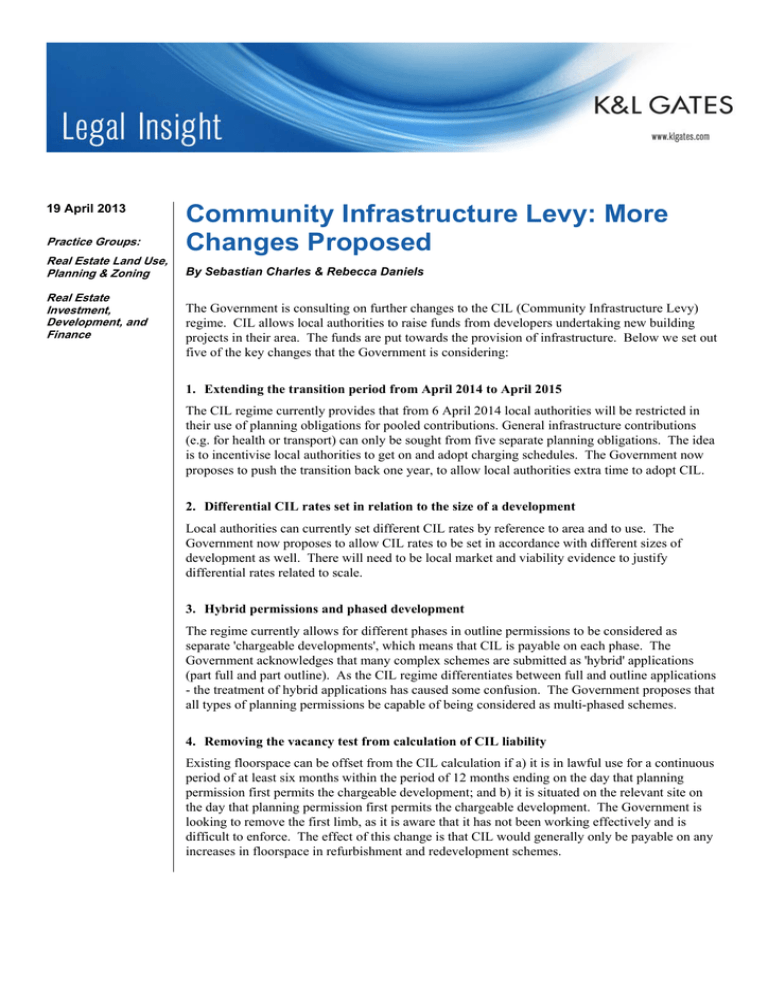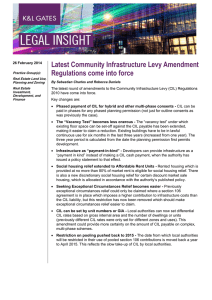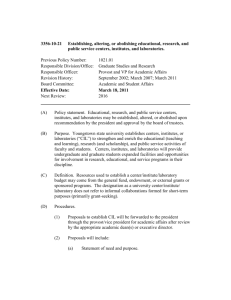
19 April 2013
Practice Groups:
Real Estate Land Use,
Planning & Zoning
Real Estate
Investment,
Development, and
Finance
Community Infrastructure Levy: More
Changes Proposed
By Sebastian Charles & Rebecca Daniels
The Government is consulting on further changes to the CIL (Community Infrastructure Levy)
regime. CIL allows local authorities to raise funds from developers undertaking new building
projects in their area. The funds are put towards the provision of infrastructure. Below we set out
five of the key changes that the Government is considering:
1. Extending the transition period from April 2014 to April 2015
The CIL regime currently provides that from 6 April 2014 local authorities will be restricted in
their use of planning obligations for pooled contributions. General infrastructure contributions
(e.g. for health or transport) can only be sought from five separate planning obligations. The idea
is to incentivise local authorities to get on and adopt charging schedules. The Government now
proposes to push the transition back one year, to allow local authorities extra time to adopt CIL.
2. Differential CIL rates set in relation to the size of a development
Local authorities can currently set different CIL rates by reference to area and to use. The
Government now proposes to allow CIL rates to be set in accordance with different sizes of
development as well. There will need to be local market and viability evidence to justify
differential rates related to scale.
3. Hybrid permissions and phased development
The regime currently allows for different phases in outline permissions to be considered as
separate 'chargeable developments', which means that CIL is payable on each phase. The
Government acknowledges that many complex schemes are submitted as 'hybrid' applications
(part full and part outline). As the CIL regime differentiates between full and outline applications
- the treatment of hybrid applications has caused some confusion. The Government proposes that
all types of planning permissions be capable of being considered as multi-phased schemes.
4. Removing the vacancy test from calculation of CIL liability
Existing floorspace can be offset from the CIL calculation if a) it is in lawful use for a continuous
period of at least six months within the period of 12 months ending on the day that planning
permission first permits the chargeable development; and b) it is situated on the relevant site on
the day that planning permission first permits the chargeable development. The Government is
looking to remove the first limb, as it is aware that it has not been working effectively and is
difficult to enforce. The effect of this change is that CIL would generally only be payable on any
increases in floorspace in refurbishment and redevelopment schemes.
Community Infrastructure Levy: More Changes
Proposed
5. Provision of infrastructure as "CIL in kind"
Currently local authorities can accept one or more land payments in satisfaction of the whole or
part of the CIL due on a scheme. The Government appreciates that there will be circumstances
when it may be a priority for a local authority to ensure the delivery of infrastructure - to facilitate
a particular development, and that the developer may be the best placed to provide it quickly, and
in a cost-effective way. The Government proposes that local authorities can accept the provision
of infrastructure in satisfaction of the whole or part of the CIL payable. This would only apply to
infrastructure which the local authority has listed as part of its policy on its website.
Summary
As CIL is adopted in more places, further flaws in the mechanics of how the regime is working
have come to light. The Government seems keen to iron out these problems, and this is to be
welcomed. The problem of double charging on applications to vary planning applications has
already been addressed (click here to link to our previous alert on 11 December). We will have to
wait until the draft amendment regulations are published be sure what changes will be carried
forward and whether they will be implemented effectively.
Please contact one of the authors or your usual K&L Gates real estate contact if your require
assistance in formulating a response to the consultation or you want advice on the potential
implications for a development scheme.
Authors:
Sebastian Charles
sebastian.charles@klgates.com
+44.(0).20.7360.8205
Rebecca Daniels
rebecca.daniels@klgates.com
+44.(0)20.7360.8219
Anchorage Austin Beijing Berlin Boston Brisbane Brussels Charleston Charlotte Chicago Dallas Doha Dubai Fort Worth Frankfurt
Harrisburg Hong Kong Houston London Los Angeles Melbourne Miami Milan Moscow Newark New York Orange County Palo Alto
Paris Perth Pittsburgh Portland Raleigh Research Triangle Park San Diego San Francisco São Paulo Seattle Seoul Shanghai
Singapore Spokane Sydney Taipei Tokyo Warsaw Washington, D.C. Wilmington
K&L Gates practices out of 48 fully integrated offices located in the United States, Asia, Australia, Europe, the
Middle East and South America and represents leading global corporations, growth and middle-market
companies, capital markets participants and entrepreneurs in every major industry group as well as public
sector entities, educational institutions, philanthropic organizations and individuals. For more information
about K&L Gates or its locations, practices and registrations, visit www.klgates.com.
This publication is for informational purposes and does not contain or convey legal advice. The information herein should not be used or relied upon
in regard to any particular facts or circumstances without first consulting a lawyer.
©2013 K&L Gates LLP. All Rights Reserved.
2








